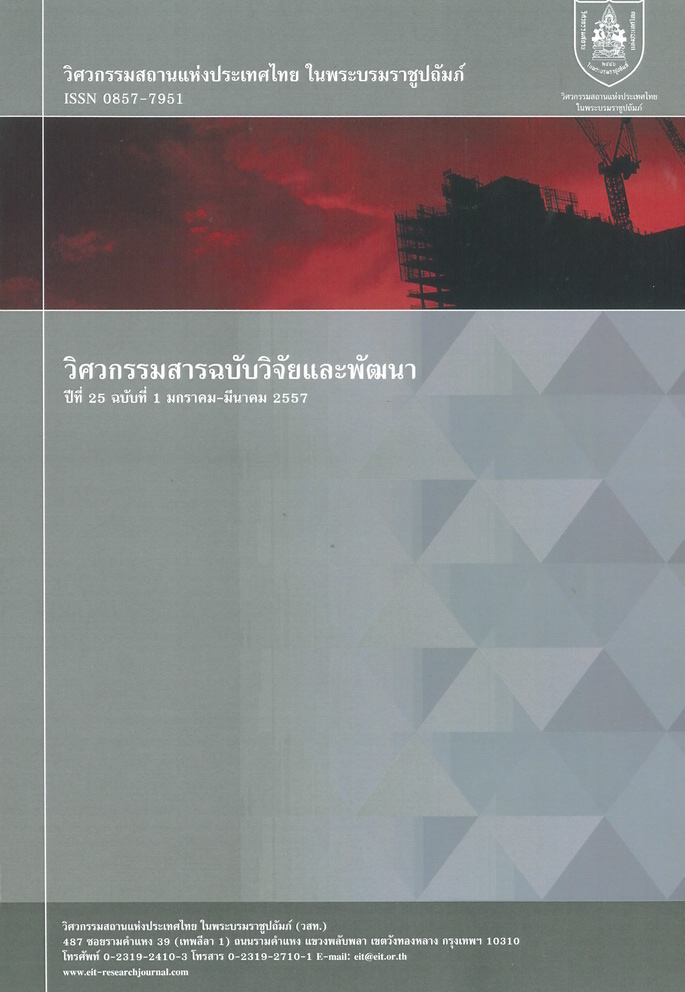Effect of Heavy Metal Bioleaching on Nutrients in Sewage Sludge
Main Article Content
Abstract
งานวิจัยนี้มีวัตถุประสงค์เพื่อศึกษาถึงความสามารถของกระบวนการไบโอลิชชิงในการกำจัดโลหะหนักและผลกระทบที่มีต่อการชะละลายของธาตุอาหารจากสลัดจ์น้ำเสียชุมชน 2 ประเภทที่แตกต่างกันได้แก่ สลัดจ์น้ำเสียที่ผ่านการย่อยสลายแบบไร้อากาศ และสลัดจ์น้ำเสียที่มีการเติมอากาศบางส่วน ทำการทดลองในปฏิกรณ์แบบแบตซ์ โดยใช้แบคทีเรียประเภทออกซิไดซ์ซัลเฟอร์ที่มีอยู่แล้วในสลัดจ์น้ำเสีย เพาะเลี้ยงที่ความเข้มข้นสลัดจ์ในช่วงร้อยละ 0.58 ถึง 4.08 ผลการศึกษาพบว่าปฏิกิริยาออกซิเดชันของซัลเฟอร์โดยแบคทีเรียทำให้เกิดขบวนการสร้างกรดมีผลทำให้ค่าพีเอชลดลงต่ำกว่า 2 ซึ่งผลจากการลดลงของค่าพีเอชทำให้โลหะหนักถูกชะละลายออกจนถึงระดับที่สามารถนำสลัดจ์ไปใช้ทางการเกษตรได้อย่างปลอดภัย โดยสามารถกำจัดทองแดงได้ถึงร้อยละ 81 ร้อยละ 76 สำหรับสังกะสี ร้อยละ 70 สำหรับนิกเกิล ร้อยละ 55 สำหรับตะกั่ว และร้อยละ 54 สำหรับแคดเมียม แต่ในขณะเดียวกันก็มีการสูญเสียธาตุอาหารจำเป็นต่อพืชในสลัดจ์ออกไป โดยมีการสูญเสียของไนโตรเจน ฟอสฟอรัส และโพแทสเซียมจากสลัดจ์ในช่วงร้อยละ 4-43 ร้อยละ 6-53 และร้อยละ 6-19 ตามลำดับ
The objectives of the present study were to investigate the capability of bioleaching process for removal of heavy metals and to examine the effects of bioleaching process on the nutrient solubilization from two different sewage sludge types (i.e. an anaerobically digested sludge and a partially aerobic digested sludge). The bioleaching experiments were carried out in a batch reactor using indigenous sulfur-oxidizing bacteria (Thiobacillus spp.) as inoculum and sewage sludge samples at the concentrations in the range from 0.58% to 4.08%. The results showed that the oxidation of elemental sulfur with the indigenous sludge thiobacilli caused a sludge acidification, decreasing the pH of sludge below 2.0 for all the sludge concentration levels. This pH decrease solubilized the heavy metals to an acceptable level for safe agricultural use. Up to 81% of Cu, 76% of Zn, 70% of Ni, 55% of Pb, and 54% of Cd can be removed from the sludges. However, loss of essential plant nutrients occurred simultaneously. Loss of nitrogen, phosphorus and potassium from the sludges were in the ranges of 4-43%, 6-53% and 6-19%, respectively.
Article Details
The published articles are copyright of the Engineering Journal of Research and Development, The Engineering Institute of Thailand Under H.M. The King's Patronage (EIT).

